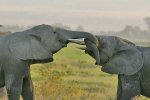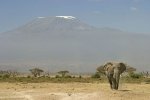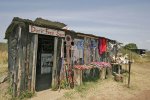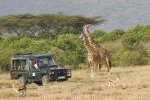Written and photographed by Bill Hirsch and Yvette Cardozo
Vol. 11 No. 5
 In a single hour on safari in East Africa, a beige cloud appeared on the horizon of the Maasai Mara plain … a thin column against the cloudless sky. As the tornado approached, its formation became a swirling tower. And then it was upon us, kicking up sand and rocks.
In a single hour on safari in East Africa, a beige cloud appeared on the horizon of the Maasai Mara plain … a thin column against the cloudless sky. As the tornado approached, its formation became a swirling tower. And then it was upon us, kicking up sand and rocks.
Five furry forms jumped up from the ground … a mother cheetah and four cubs. Disturbed from their afternoon siesta under an acacia tree, they loped across the dirt, finally snuggling down under a new tree where the cubs (hardly 10 feet from us) wrestled with each other, with twigs, with leaves and anything else that moved. After they went back to sleep, we moved beneath our own shade tree along a river bank where, soon enough, a line of hippos floated by.
 Further upriver, a large mixed herd of wildebeests and zebras paced back and forth at the bank. For 15 minutes, they milled aimlessly, no doubt weighing the risks of the two huge crocodiles waiting patiently in the water.
Further upriver, a large mixed herd of wildebeests and zebras paced back and forth at the bank. For 15 minutes, they milled aimlessly, no doubt weighing the risks of the two huge crocodiles waiting patiently in the water.
Then one lone wildebeest climbed in and swam across. And suddenly, the whole herd was on the move, lunging and leaping, climbing atop once another in a frothing cloud of spray and dust … all swirling horns and hooves and arching backs.
The great migration was in full swing. Lines of wildebeests and herds of zebras moved inexorably across the plain. Although the animals are always on the move from drier to moister areas, the main migration starts in May on the Serengeti in Tanzania and moves north to the Maasai Mara in Kenya and eventually returns … a round trip covering 300 miles. That’s a million wildebeests, 200,000 zebras, 300,000 Thomson’s gazelles. And following the food chain was hungry lions, hyenas, vultures, cheetahs.
And we were in the middle of it all.
 There are plenty of places on earth to see animals … blue footed booby birds in the Galapagos, penguins in the Antarctic, moose in Alaska, walrus in northern Canada. But the gold standard remains East Africa. Things may be more intimate in South Africa, where you might be able to follow a single leopard family all day. But nothing is quite like the herds thundering across the vast, dusty, grassy plains of Kenya and Tanzania.
There are plenty of places on earth to see animals … blue footed booby birds in the Galapagos, penguins in the Antarctic, moose in Alaska, walrus in northern Canada. But the gold standard remains East Africa. Things may be more intimate in South Africa, where you might be able to follow a single leopard family all day. But nothing is quite like the herds thundering across the vast, dusty, grassy plains of Kenya and Tanzania.
“One hundred elephants. I can guarantee you that,” our guide Alfred Mutai promised that first day in Amboseli National Park. “It might be 500 but to be safe, let’s say 100.” We quit counting well above the 200 mark that afternoon. And we had seen only a fraction of Amboseli’s 1,398 elephants.
 Our safari with Micato Safaris was a sampler … three wildlife parks and a safari club in 10 days. There are longer trips but ours was more than enough to see nearly everything: elephants, rhinos, hippos, Cape buffalo, cheetahs, hyenas, two species of zebra, and gazelles. We were so wrapped up photographing lions that we missed the leopards.
Our safari with Micato Safaris was a sampler … three wildlife parks and a safari club in 10 days. There are longer trips but ours was more than enough to see nearly everything: elephants, rhinos, hippos, Cape buffalo, cheetahs, hyenas, two species of zebra, and gazelles. We were so wrapped up photographing lions that we missed the leopards.
Amboseli is at the foot of the 19,340 foot Mt. Kilimanjaro, Africa’s highest mountain. The snowcapped peak sets the stage for everything. There is nothing more breathtaking than an elephant or a giraffe profiled by the setting sun against the towering cone.
The flat plane of Amboseli stretches for miles, ending abruptly at the mountain. And against this blue gray wall is a tapestry of animals along with swirling dust that rises in columns … as if the whole place was on fire. There are so many animals that it takes time to realize the numbers before you. Like donkeys, hundreds upon hundreds of zebras grazing and galloping and braying; wildebeests trotting back and forth in endless lines, the occasional giraffe, a rhino or two, hyenas, and elephants. Herds and more herds of elephants wander back and forth, stirring up great tan clouds of smoky dust.
 We watched two juvenile elephants play-fight, entwining their trunks and pushing back and forth. We watched hyena pups snuggle and yawn. We watched young lions trot just yards across our path.
We watched two juvenile elephants play-fight, entwining their trunks and pushing back and forth. We watched hyena pups snuggle and yawn. We watched young lions trot just yards across our path.
And this was just the drive from the airport to our lodge. At Ol Tukai lodge, we had lunch while herds of zebras and Cape buffalo grazed on the other side of a wire fence, just yards away.
That night, the stars were breathtaking. They were so brilliant that we could see where the Milky Way split into a Y. We’ve been at sea away from all lights but nothing equaled this. It was, we were told, because at the Equator there’s less atmospheric interference.
 The next day, we visited the Maasai village of Inchurra — 125 people, 87 cows. The Maasai people are among the few Kenyan tribes that have not been assimilated into modern culture. Many still live in cow dung huts, wear the signature bright red woolen cloth, follow tribal rules and eat virtually nothing more than meat (cow, sheep and goat), milk and cow’s blood.
The next day, we visited the Maasai village of Inchurra — 125 people, 87 cows. The Maasai people are among the few Kenyan tribes that have not been assimilated into modern culture. Many still live in cow dung huts, wear the signature bright red woolen cloth, follow tribal rules and eat virtually nothing more than meat (cow, sheep and goat), milk and cow’s blood.
A standard village visit involves a dance by young warriors and women, visits to their huts and maybe a fire making demo. But we were more interested in the food, so for a slightly larger fee (negotiated on the spot), a group of elder men invited us to share their goat.
Fire making here is an art and involves twirling a soft cedar stick in a small hole drilled into hard acacia, then teasing the tiny spark until it ignites a tuft of grass, followed by bits of wood.
 Young warriors … growing teenage boys, actually … can put away five pounds of meat a day. This is washed down with a couple of quarts of cow’s blood and milk.
Young warriors … growing teenage boys, actually … can put away five pounds of meat a day. This is washed down with a couple of quarts of cow’s blood and milk.
The milk is a story by itself. The village chief’s son, Tobiko Ole, brought out a long, thin gourd. “We rub a burned stick on the inside. This keeps the milk fresh for three days.” Not an easy feat when you consider the average summer daytime temperature can easily hit a withering 95 degrees.
We peered into the gourd and saw creamy white milk laced with lines of floating charcoal dust. It tasted like … well … warm, fresh milk. You couldn’t detect the charcoal at all.
And then we got to the goat.
 The men used their swords to carve off thin strips of meat. It was fragrant, oily, quite chewy and delicious. We finished off with the favored ribs. In the old days, Tobiko explained, only warriors and elder men ate the ribs, usually at hunting camps far from the village. “But times have changed and now our guests can join us.”
The men used their swords to carve off thin strips of meat. It was fragrant, oily, quite chewy and delicious. We finished off with the favored ribs. In the old days, Tobiko explained, only warriors and elder men ate the ribs, usually at hunting camps far from the village. “But times have changed and now our guests can join us.”
From Amboseli, we went to The Ark in Aberdares National Park. The lodge is shaped like a ship and even calls its floors “decks. The most striking thing is, frankly, the cold. Even though this is virtually the Equator, it’s at 7,500 feet. The temperature sank below 50 degrees that night and we put on nearly our entire wardrobe (including wool hats) to keep warm.
“You do not have to think at all. This is your vacation and thinking is my job,” Alfred told us cheerily. “I will take care of your luggage, arrange for your vans, and tell you when to shoot your camera.” And, astonishingly, he did.
The high point of effortless animal watching came at Sweetwaters, a tent camp at Ol Pejeta Ranch. You may sleep in canvas but this is hardly roughing it. The tents come with running hot water, tile floors, rugs and, best of all, a front porch located just yards from a waterhole with a never ending parade of wildlife. There are no tall fences here; just a shallow ditch with a low wire that somehow keeps people and animals apart.
 And so we sat there having afternoon tea as five giraffes came to drink. There were four adults and a juvenile who was all spindly legs and awkwardness as he splayed his front legs out wide and bent cautiously to get his mouth in the water. Soon enough, the giraffes were joined by zebras, gazelles, warthogs and dozens of kinds of birds. We’ve seen zoos with less.
And so we sat there having afternoon tea as five giraffes came to drink. There were four adults and a juvenile who was all spindly legs and awkwardness as he splayed his front legs out wide and bent cautiously to get his mouth in the water. Soon enough, the giraffes were joined by zebras, gazelles, warthogs and dozens of kinds of birds. We’ve seen zoos with less.
And then came Maasai Mara.
First, a balloon ride to watch herds of zebras and wildebeests galloping across the golden grass at dawn. Then a bone jarring Jeep trek to Maasai Mara Reserve to hopefully catch a bit of migration.
The animals follow the growing grass, which gets nearly three feet tall. It was hard to believe that in a month or two it would all be gone … grazed clear to the ground by two million animals. Zebras eat the top of the grass, wildebeest eat the bottom and other animals finish off what’s left.
 At one area of the river, we sat in our Jeep while almost within touching distance, dozens of wildebeest and zebras formed almost perfectly straight lines at the water. The wildebeest drank a bit, then something spooked them and they stampeded up the bank only to be replaced by a line of zebras that drank until they were spooked.
At one area of the river, we sat in our Jeep while almost within touching distance, dozens of wildebeest and zebras formed almost perfectly straight lines at the water. The wildebeest drank a bit, then something spooked them and they stampeded up the bank only to be replaced by a line of zebras that drank until they were spooked.
For lunch, we got to see that river crossing. And on our last morning, as we waited for the van to the airport, we got one last gift. Half a dozen hippos showed up in the river below Cabin 18 of the Mara Safari Club.
Two babies played in the water, diving and surfacing to twitch their little pink ears. And then two juvenile males started sparring, their enormous mouths open as they bumped their teeth against each other. Of course, our cameras were already packed. We’ll just have to go back.
If you go:
Micato Safaris offers a half dozen game viewing trips in East Africa ranging in length from 12 to 17 days and from approximately $5,000 to $10,000 US depending on the length and itinerary of the trip. The price is inclusive with the exception of airfare to Africa, www.micato.com, 800.642.2861.
